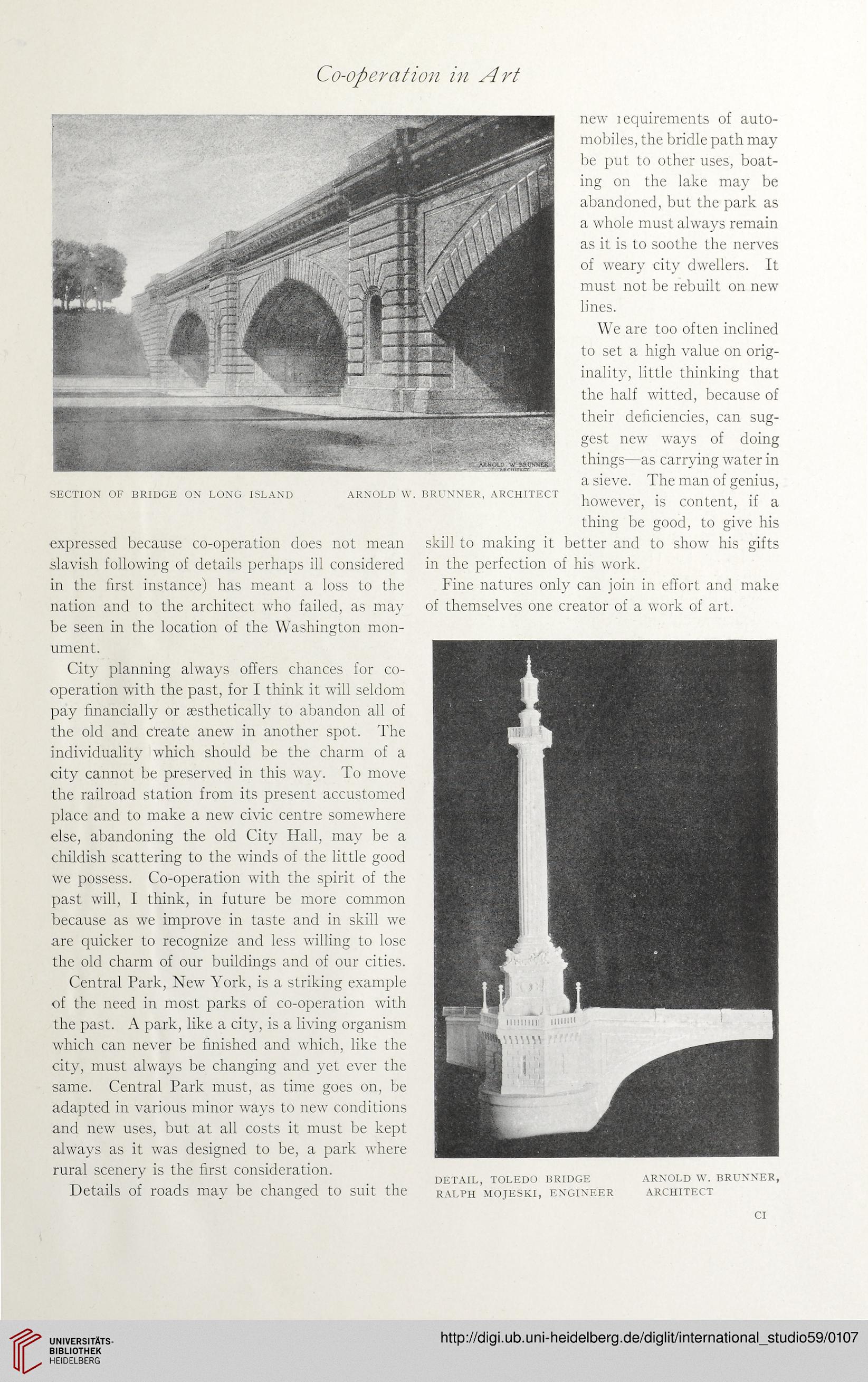Co-operation in Art
SECTION OF BRIDGE ON LONG ISLAND ARNOLD W.
expressed because co-operation does not mean
slavish following of details perhaps ill considered
in the first instance) has meant a loss to the
nation and to the architect who failed, as may
be seen in the location of the Washington mon-
ument.
City planning always offers chances for co-
operation with the past, for I think it will seldom
pay financially or aesthetically to abandon all of
the old and create anew in another spot. The
individuality which should be the charm of a
city cannot be preserved in this way. To move
the railroad station from its present accustomed
place and to make a new civic centre somewhere
else, abandoning the old City Hall, may be a
childish scattering to the winds of the little good
we possess. Co-operation with the spirit of the
past will, I think, in future be more common
because as we improve in taste and in skill we
are quicker to recognize and less willing to lose
the old charm of our buildings and of our cities.
Central Park, New York, is a striking example
of the need in most parks of co-operation with
the past. A park, like a city, is a living organism
which can never be finished and which, like the
city, must always be changing and yet ever the
same. Central Park must, as time goes on, be
adapted in various minor ways to new conditions
and new uses, but at all costs it must be kept
always as it was designed to be, a park where
rural scenery is the first consideration.
Details of roads may be changed to suit the
BRUNNER, ARCHITECT
skill to making it
in the perfection of his work.
Fine natures only can join in effort and make
of themselves one creator of a work of art.
new lequirements of auto-
mobiles, the bridle path may
be put to other uses, boat-
ing on the lake may be
abandoned, but the park as
a whole must always remain
as it is to soothe the nerves
of weary city dwellers. It
must not be rebuilt on new
lines.
We are too often inclined
to set a high value on orig-
inality, little thinking that
the half witted, because of
their deficiencies, can sug-
gest new ways of doing
things—as carrying water in
a sieve. The man of genius,
however, is content, if a
thing be good, to give his
better and to show his gifts
DETAIL, TOLEDO BRIDGE ARNOLD W. BRUNNER,
RALPH MOJESKI, ENGINEER ARCHITECT
CI
SECTION OF BRIDGE ON LONG ISLAND ARNOLD W.
expressed because co-operation does not mean
slavish following of details perhaps ill considered
in the first instance) has meant a loss to the
nation and to the architect who failed, as may
be seen in the location of the Washington mon-
ument.
City planning always offers chances for co-
operation with the past, for I think it will seldom
pay financially or aesthetically to abandon all of
the old and create anew in another spot. The
individuality which should be the charm of a
city cannot be preserved in this way. To move
the railroad station from its present accustomed
place and to make a new civic centre somewhere
else, abandoning the old City Hall, may be a
childish scattering to the winds of the little good
we possess. Co-operation with the spirit of the
past will, I think, in future be more common
because as we improve in taste and in skill we
are quicker to recognize and less willing to lose
the old charm of our buildings and of our cities.
Central Park, New York, is a striking example
of the need in most parks of co-operation with
the past. A park, like a city, is a living organism
which can never be finished and which, like the
city, must always be changing and yet ever the
same. Central Park must, as time goes on, be
adapted in various minor ways to new conditions
and new uses, but at all costs it must be kept
always as it was designed to be, a park where
rural scenery is the first consideration.
Details of roads may be changed to suit the
BRUNNER, ARCHITECT
skill to making it
in the perfection of his work.
Fine natures only can join in effort and make
of themselves one creator of a work of art.
new lequirements of auto-
mobiles, the bridle path may
be put to other uses, boat-
ing on the lake may be
abandoned, but the park as
a whole must always remain
as it is to soothe the nerves
of weary city dwellers. It
must not be rebuilt on new
lines.
We are too often inclined
to set a high value on orig-
inality, little thinking that
the half witted, because of
their deficiencies, can sug-
gest new ways of doing
things—as carrying water in
a sieve. The man of genius,
however, is content, if a
thing be good, to give his
better and to show his gifts
DETAIL, TOLEDO BRIDGE ARNOLD W. BRUNNER,
RALPH MOJESKI, ENGINEER ARCHITECT
CI





